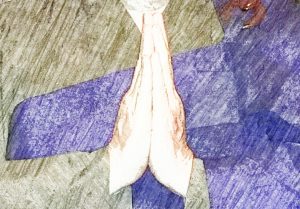Bringing Our Hands Together
(To view the October 2018 newsletter where this was first published click here.)

Today, when I was at Home Depot, I came around a corner and looked up to see a smiling person bringing their hands together with a gesture of prayer, and bowing to me. As a reflex, I automatically put my hands together and bowed to her and returned her smile. This is one of a string of similar recent incidents around town with people who I have never met before and they always cheer me up. I once read that as a child in Thailand, the first thing you are taught, when going to a temple, is to make gassho, that gesture of bringing the hands together in prayer. The gassho is a sort of universal gesture of respect and appreciation that Buddhists use throughout the world, so I thought I might talk a little about what it means.
The gassho is one of what in Sanskrit are called mudras and first, maybe it would be helpful explain what the word mudra means, since it doesn’t really have a satisfactory English translation. A mudra is a body or hand posture that both communicates and inwardly cultivates a spiritual state. You can see many mudras in religious iconography, particularly from Buddhism and the Hindu forms of expression. The mudras are said to move energy in a beneficial way similar to acupuncture.
The gassho has many variations used in different circumstances and according to different traditions. In general, the mudra is an expression of respect and religious recognition, even as it is used in western Abrahamic cultures. I was recently talking about the gassho with a sadhu in the Ananda Marga tradition (an Indian meditation tradition) and he said that the gassho as they do it has the basic meaning of “Universal Consciousness in me recognizes and pays respect to Universal Consciousness in You.” I will often tell people that the gassho, for us, means that “Buddha Nature in me recognizes and pays respect to Buddha Nature in you.”
Beyond this basic meaning, which has its own fullness, each way of making gassho also has specific meaning. For us, the form we use is like the image above (arms basically level with no space between the palms and fingers which are held closely together in a relaxed and firm way) and it signifies the bringing together of the opposites or bringing together all the scattered aspects of ourselves.
Another way to describe the meaning of the gassho is to say that the fingers of the left hand are the realms where training is received and accepted: the worldly heavens, and the realms of the Buddhas, Bodhisattvas, Arahants and Pratyekabuddhas, and the fingers of the right hand represent the realms where training hasn’t been fully accepted: the realms of the humans, animals, hungry ghosts, hells and jealous asuras. When we make gassho, in a small way, we bring those worlds together and we bring training to life right where we are, in whatever state we might be in.
It is a foundation of practice to bring together that which resists practice with that which sees the value of practice, like bringing our hands together in gassho.
While it is important to recognize that there is a way we can make gassho inwardly, without the outward physical form (and this is handy when we are in situation where we don’t want to stand out), I have found it helpful to physically make the mudra from time to time. (When I worked in busy commercial kitchens I would sometimes take a minute to make gassho while I was in the walk-in refrigerator, to help ground and gather myself.)
This mudra is very old and probably predates even the Buddha. In this oldness, when I use it, it connects me to the Buddha himself and to the wisdom of all those generations of people who have made use of the mudra to express their inner intentions. I rarely think about things like what bringing my fingers together means, like which finger represents which world, but somehow, the making of this mudra has helped me in my practice and it connects me to a whole community of people all over the world and throughout time.


